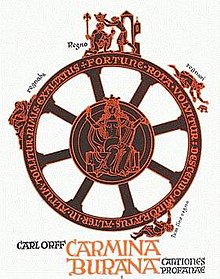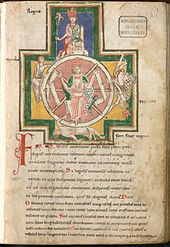Carl Orff - O Fortuna ~ Carmina Burana
Jan. 3rd, 2019 07:51 pmCarmina Burana is a scenic cantata composed in 1935 and 1936 by Carl Orff, based on 24 poems from the medieval collection Carmina Burana. Its full Latin title is Carmina Burana: Cantiones profanae cantoribus et choris cantandae comitantibus instrumentis atque imaginibus magicis ("Songs of Beuern: Secular songs for singers and choruses to be sung together with instruments and magical images"). It was first performed in Frankfurt on 8 June 1937. It is part of Trionfi, a musical triptych that includes Catulli Carmina and Trionfo di Afrodite. The first and last movements of the piece are called "Fortuna Imperatrix Mundi" ("Fortune, Empress of the World") and start with the very well known "O Fortuna".
In 1934, Orff encountered the 1847 edition of the Carmina Burana by Johann Andreas Schmeller, the original text dating mostly from the 11th or 12th century, including some from the 13th century. Michel Hofmann [de] was a young law student and an enthusiast of Latin and Greek; he assisted Orff in the selection and organization of 24 of these poems into a libretto, mostly in secular Latin verse, with a small amount of Middle High German Old Provençal, and Old French. The selection covers a wide range of topics, as familiar in the 13th century as they are in the 21st century: the fickleness of fortune and wealth, the ephemeral nature of life, the joy of the return of Spring, and the pleasures and perils of drinking, gluttony, gambling, and lust.


https://en.wikipedia.org/wiki/Carmina_Burana_(Orff)
The composition appears in numerous films and television commercials and has become a staple in popular culture, setting the mood for dramatic or cataclysmic situations. For instance, it is used to portray the torment of Jim Morrison's drug addiction in the film The Doors. In 1983, Doors' keyboardist Ray Manzarek released his third solo album, Carmina Burana, which is an interpretation of the piece in a contemporary framework.
https://en.wikipedia.org/wiki/Carl_Orff%27s_O_Fortuna_in_popular_culture
In 1934, Orff encountered the 1847 edition of the Carmina Burana by Johann Andreas Schmeller, the original text dating mostly from the 11th or 12th century, including some from the 13th century. Michel Hofmann [de] was a young law student and an enthusiast of Latin and Greek; he assisted Orff in the selection and organization of 24 of these poems into a libretto, mostly in secular Latin verse, with a small amount of Middle High German Old Provençal, and Old French. The selection covers a wide range of topics, as familiar in the 13th century as they are in the 21st century: the fickleness of fortune and wealth, the ephemeral nature of life, the joy of the return of Spring, and the pleasures and perils of drinking, gluttony, gambling, and lust.


https://en.wikipedia.org/wiki/Carmina_Burana_(Orff)
The composition appears in numerous films and television commercials and has become a staple in popular culture, setting the mood for dramatic or cataclysmic situations. For instance, it is used to portray the torment of Jim Morrison's drug addiction in the film The Doors. In 1983, Doors' keyboardist Ray Manzarek released his third solo album, Carmina Burana, which is an interpretation of the piece in a contemporary framework.
https://en.wikipedia.org/wiki/Carl_Orff%27s_O_Fortuna_in_popular_culture